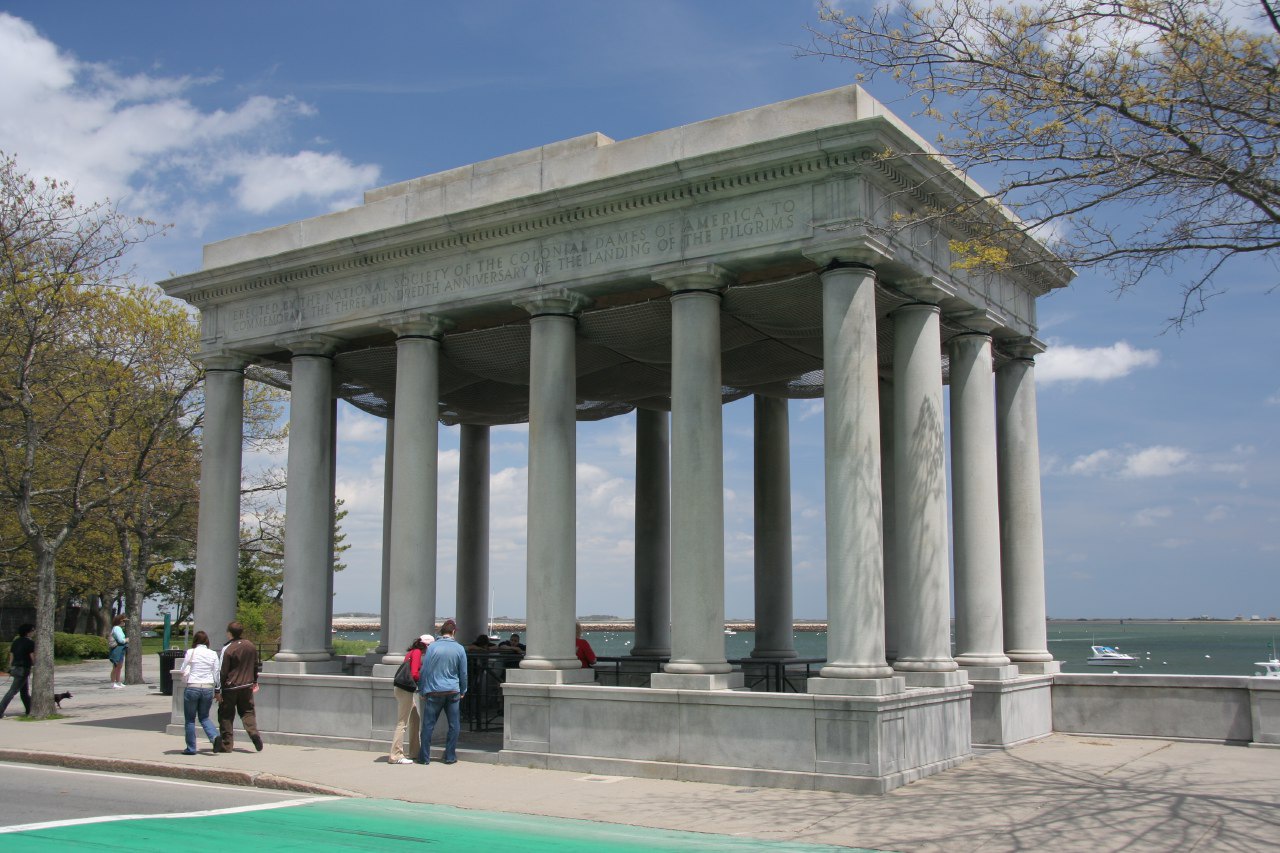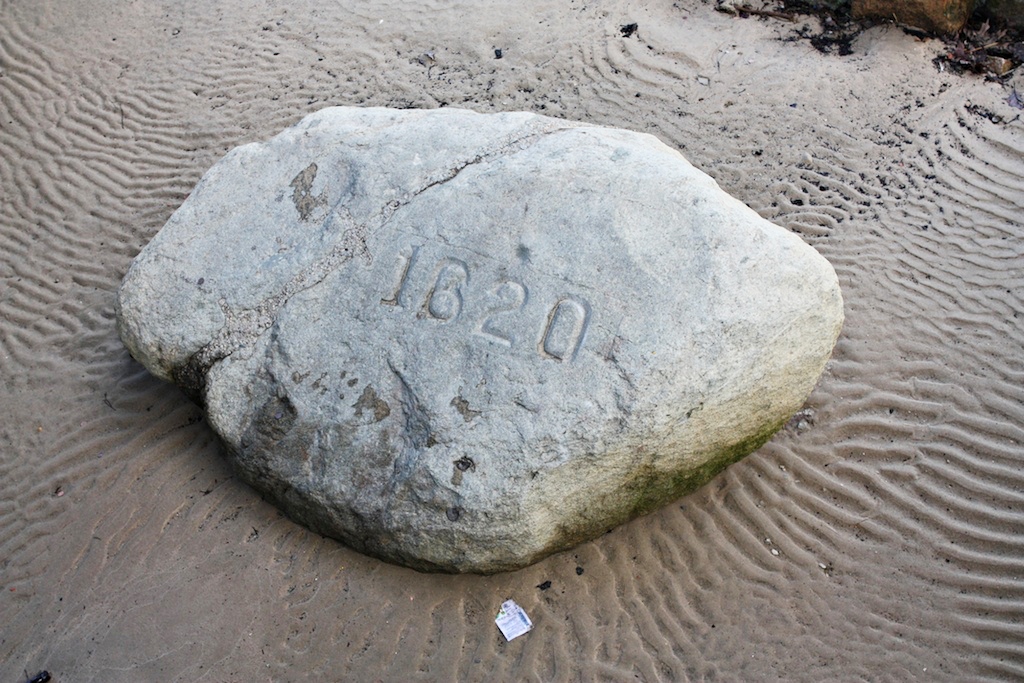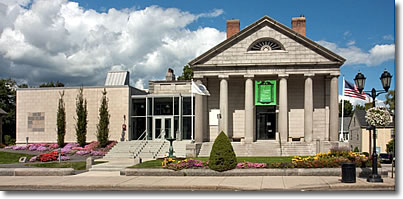Massachusetts South Shore
Many make the pilgrimage to Plymouth every summer to see one of the places where this country began, but Quincy, New Bedford and Fall River are also worth a visit.

Plymouth Rock enclosure, where the Pilgrims stepped ashore (1620).
Of the many communities on the South Shore of Massachusetts Bay, Plymouth, 40 miles (63 km) south of Boston, is easily the most famous. It makes a logical day trip from Boston, or a stop on the way to or from the city.
You can visit the historic city of Quincy, only 10 miles (16 km) south of Boston, reachable by MBTA Commuter Rail train. Quincy is home of Adams National Historical Park, on the same excursion to see the birthplaces of John Adams and John Quincy Adams, the family farm at Peacefield, and United First Parish Church, which the Adams family attended and supported, and in which these two Presidents of the United States are buried.
Farther south, you may also want to visit the 19th-century whaling port of New Bedford and the old textile center of Fall River on your way to Cape Cod, Providence or Newport RI.
You can reach Quincy easily from Boston by MBTA Commuter Rail train, but private car is the best way to reach the other towns. However, P&B buses travel from Boston to Plymouth, New Bedford and Fall River. More...
Quincy
John Adams, Abigail Smith Adams, John Quincy Adams and others of the Adams family had a profound effect on the history of the USA. Trace their roots in their old home town of Quincy MA, 10 miles (16 km) south of Boston.
You can reach Quincy easily from Boston by MBTA Commuter Rail train.
Adams National Historical Park
The houses where Presidents of the United States John Adams and John Quincy Adams were born, the fine old house in which John and Abigail Smith Adams spent their later years, and the church in which the two presidents are buried, are now included in the Adams National Historical Park.
Presidents John Adams and John Quincy Adams, and wife and mother Abigail Smith Adams, are the most famous members of the family commemorated by the Adams National Historical Park in Quincy MA, but in fact you'll learn about four generations of the family on your visit.
The national park is open daily, 9 am to 5 pm, from April 19th (Patriots Day) to November 10th.
The National Park Visitor Center is at 1250 Hancock Street in the "Galleria at President's Place" building in the center of Quincy (map), across the street from United First Parish Church. This is the starting point for park tours, which take about two hours (last tour leaves at 3:15 pm).
The main sites to visit are:
Peacefield
The Adams homestead, to which John Adams, second president of the United States, retired after his long years of service to his country. The estate includes the Old House and the Stone Library, with its 14,000 volumes.
John Adams (1735-1826), first Vice-President of the United States, and second President of the United States (1797-1801), bought this 40-acre (16-hectare) property in Quincy, Massachusetts (map) in 1787 while still resident in London.
Returning to Quincy in 1788, he and his wife Abigail Smith Adams (1744-1818) moved into what was a then very simple—primitive—residence dating from 1731. They set about improving both its architecture and its comforts.
After his election defeat by Thomas Jefferson in 1800, the Adamses moved from Philadelphia and returned to the "Old House," which they named Peacefield.
Their son John Quincy Adams (1767-1848), diplomat and sixth president of the United States, lived here as well, later with his wife, First Lady Louisa Catherine Adams.
They were followed in residency at Peacefield by other distinguished members of the Adams family, including Charles Francis Adams, United States Minister (ambassador) to Great Britain during the American Civil War; and literary men Henry Adams (as in The Education of Henry Adams) and Brooks Adams.
The house was occupied by the Adams family until 1927. In 1946 it was donated by the family to the US National Park Service as a historical site.
The Stone Library (1873) next to the Old House has the Adams' collection of 14,000 books.
The grounds are open to all. The Old House and Stone Library are open by guided tour during the Adams National Historical Park's visiting season.
Adams Birthplaces
John Adams was born in a modest-looking, darkly weathered New England "saltbox" house which now stands near the center of Quincy, Massachusetts, less than two miles from Peacefield.
This modest farmhouse (map) in Quincy was John Adams' home during his boyhood, youth and young married life with Abigail Smith Adams.
It served as his law office as well. Here, working with Samuel Adams and James Bowdoin, he wrote the Constitution of the Commonwealth of Massachusetts, among the earliest and best of American state constitutions. It served as a model for the United States Constitution.
Next to the old Adams house, a newer, larger, more stately wood frame building is the birthplace of John Quincy Adams.
United First Parish Church
The church in the center of Quincy, attended and supported by the Adams family during their lives, holds them in death. Both Presidents Adams are buried here, along with other family members.
Quincy's United First Parish Church (Unitarian-Universalist) , 1306 Hancock Street (map), was founded in 1636 by Puritans as an offshoot of the Church in Boston, but by 1639 "The Church of Braintry," as it was called, was independent.
John Hancock was baptized in this church by his father, the Reverend John Hancock, who served here as minister from 1726 to 1744.
In 1750 the church became a Unitarian congregation. The church and its congregation were the nucleus of the town of Braintree, Massachusetts, later called "Old Braintree."
The town grew, and eventually "Old Braintree" became the City of Quincy, while other districts became the towns of Braintree, Holbrook and Randolph.
Presidents John Adams and John Quincy Adams were life-long members of this church.
The stately building you see today was designed by Alexander Parris, built of granite donated by John Adams, and completed in 1828. It replaced the wooden Hancock Meeting House that was on the same site.
The granite church is the congregation's fourth meetinghouse. The tombs of John Adams and John Quincy Adams are in a crypt within the church, beside those of their wives, Abigail Smith Adams and Louisa Catherine Adams.
You'll find the church in the very center of Quincy (map), directly across the street from City Hall. Across the street beside it is the Visitor Center of Adams National Historical Park.
Plymouth
Plymouth, Massachusetts, is famous because of a small and rather unimpressive boulder—but "America's Hometown" has lots more to visit beyond Plymouth Rock.
When visitors come to see Plymouth Rock, 40 miles (64 km, 50 minutes' drive) southeast of Boston MA (map), they are coming not because the rock is much to look at, but because the town of Plymouth, as the landing place of the Pilgrims, is a symbol for the ideal of religious freedom and the quest for a better life.
Other than its famous attractions, Plymouth—which calls itself "America's Hometown"—is a workaday sort of place, a working-class and middle-class Massachusetts South Shore community that's a nice enough place to live, but not a place to linger long if you're just visiting.
1620 & More
The Pilgrims arrived not in a wilderness, but in a rich, populated land. So why did half of them die of privation the first winter?
The Pilgrims were not explorers, they were refugee settlers.
Terra Cognita?
The coasts of New England and (later) New York were not terra incognita ("unknown land"). In 1524 Giovanni da Verrazzano had discovered the estuary that would become New York harbor. By 1600, the shores of New England were a regular stopping-point for European fishing boats.
In 1609 Henry Hudson stopped at Cape Cod on his way to what would become New Netherland. Dutch trader Adriaen Block mapped the coast from 1611 to 1614 and left his name on Rhode Island's Block Island.
So by the time the Pilgrims decided to make the voyage to the New World and settle there, descriptions of the fertility of the land, equability of the climate, and friendliness of the natives brought back by explorers and fishermen were widespread in Europe.
The Original Inhabitants
Neither were the shores of New England uninhabited when the Pilgrims arrived. In 1600, there were thriving Algonquin ("Indian") villages all over eastern Massachusetts, with particular concentrations near the shore where seafood was abundant and the climate more moderate.
Dutch traders had set up a lively village in New Netherland (later New Amsterdam, still later New York) in 1614, six years before the Pilgrims arrived.
Much of the region's land had been cleared by the Algonquins for family gardens, cornfields, berry fields, wild fruit and nut orchards, and hunting grounds.
Unwelcome Newcomers
But the European fishermen who stopped and got to know the natives left behind deadly souvenirs: bacteria and viruses unknown in the New World, against which the local people had no natural ly-acquired immunity.
Smallpox, syphilis and other "European" diseases spread like wildfire through the Algonquin villages of Massachusetts Bay, and within a generation this well-populated land was nearly empty. It's estimated that up to 75% of the people died, leaving their cleared, prepared lands open for the Pilgrim settlers.
A Different Kind of Farming
Even though the land was prepared for them, the Pilgrims were not well prepared for the land. The agricultural lands and hunting grounds that had provided an abundant living to the Algonquins would not do so right away for the Pilgrims.
The Europeans, used to growing wheat and herding cattle, found themselves in a land best suited to maize (corn) farming, turkey and deer hunting, and fishing for cod, oysters, clams and lobsters.
During the first hard winter at Plymouth, about half of the Pilgrims died. The rest survived largely through the beneficence of their Indian neighbors, who taught them how to hunt and fish, to plant maize, fertilizing the cornhills with fish waste, to collect berries and nuts, and to store produce underground.
On many occasions, the generosity and providence of the Algonquins, and barter, provided the Pilgrims with food to get through hard times.
Within two decades of the Pilgrims' arrival at Plymouth, European settlers' villages were flourishing on the shores of Massachusetts Bay and beginning to appear inland along the banks of rivers reached from the sea.
What to See & Do
Besides the Rock—its only notable features are a crack and the date "1620" engraved on it, which will take you about 5 minutes to inspect—Plymouth has lots of other sights and exhibits dealing with Pilgrim and Early American history.
Plymouth Rock
Such a grand temple for a simple granite boulder? There's no proof that the Pilgrims even landed on Plymouth Rock, but the Rock does have a fascinating history.

Plymouth Rock is an American icon, a symbol of intrepid discovery, liberty, and freedom of conscience.
From anywhere in Plymouth, Massachusetts, road signs and residents guide you to Plymouth Rock on the waterfront.
A Bit of Geology
The stone itself is granite, probably from a formation known as the Dedham granite, formed 608 million years ago (give or take 17 million years)—that is, a long time before 1620!
The Rock was picked up from this formation at a spot south or west of Boston and transported by a glacier to the spot later named Plymouth about 20,000 years ago. The spot it left was somewhere in the terrane (specific geologic area) called Atlantica, which surrounds Boston.
Geologists who study plate tectonics say that many millions of years ago there was a huge continent called Pangaea (pan-JEE-uh) which split into eastern and western parts, the eastern becoming Europe and Africa, the western part North America.
The Dedham granite is found mostly in Africa, so it is surprising to consider that Plymouth Rock came over from another continent just as the Pilgrims did, only millions of years earlier!
The Pilgrims Arrive
When the Pilgrims arrived, they may or may not have stepped on Plymouth Rock. If they did, they never mention it in their letters and written accounts. In any case, the Rock was much larger in 1620, but erosion by sea and wind has reduced it to a mere fraction of its former self.
Nature played havoc with the Rock, but humans did worse, chipping off small pieces for patriotic souvenirs, taking large pieces to put on display to build patriotic fervor, even using it as part of a wharf at one time.
In 1774, twenty yoke of oxen came to move Plymouth Rock, and it split in the process. Half of the Rock was put on display at Pilgrim Hall Museum from 1834 to 1867, but was then brought back here.
In November 1989, the Rock was repaired and strengthened to withstand the blows from the sea and the laserlike gazes and tossed coins of a million affectionate visitors.
Today Plymouth Rock is sheltered by a monumental enclosure, designed by McKim, Mead & White and built in 1921, which stands in the Commonwealth of Massachusetts' Pilgrim Memorial State Park.
Just as the Rock marks the beginning of the Pilgrims' adventure in America, so it can serve as the beginning point for your tour of Plymouth. After your look at it, head for the Mayflower II, moored only a few minutes' stroll away.
Mayflower II
At the State Pier on Water Street, you'll want to visit this full-size replica of the Pilgrim ship Mayflower, built in England and sailed across the Atlantic to Plymouth MA in 1957.
The fact that the Pilgrims suffered to get to America will be brought home more forcefully when you tour the Mayflower II, a replica of the original ship built in England in 1955 and sailed across the Atlantic to Plymouth in 1957.
Visiting Mayflower II
Mayflower II is only a few steps north of Plymouth Rock (which is three miles north of Plimoth Platuxet itself; map). The ship's audiovisual show at the theater and indoor exhibits on Puritanism and early Pilgrim life are open. If you plan to visit both Plimoth Plantation and Mayflower II, be sure to buy the discounted combination ticket.
A museum shop and picnic area are at the Mayflower II site as well, and there are restaurants and snack shops right across the street.
A Bit of History
How, you are sure to ask yourself, was it possible for 102 people—even small ones, even devout Puritans—to fit themselves and all their baggage for a two-month sea voyage and the setting up a new town into the tiny rooms and onto the tiny decks of this little ship?
(Part of the reason is that the Mayflower's companion ship, the mis-named Speedwell, proved unseaworthy, and all of its passengers had to be squeezed onto the Mayflower as well.)
And how could they stay on this little ship for two months?
The only answer that comes to mind is "by courage and dedication," and it's for that the Pilgrims are admired and remembered.
400th Anniversary
Interestingly, the town of Harwich, England, northeast of London, claims to be where the original Mayflower was built.
With the Harwich Mayflower Project, Harwich used 400 tons of English oak to build the $3.3-million replica of the Mayflower and sailed it to Plymouth, Massachusetts, for the 2020 celebration of the 400th anniversary (1620-2020) of the Mayflower's sailing.
(As Harwich has it, the Mayflower originally sailed from Harwich, but sought port in Plymouth when the Mayflower's sister ship, the Speedwell, sprang a leak. So the Pilgrims' original port of embarkation was Harwich.)
Plimoth Patuxet Museums
This authentic re-creation of an entire Pilgrim village from 1627, at 137 Warren Avenue, complete with living inhabitants, takes you—and especially children—back in time.
Even the animals are authentic to the time. Formerly known as Plimoth Plantation, the name was changed to better reflect the shared history and society of the European immigrants and the native Wampanoag people who received them here.
Most lifelike of all the representations of early colonial life is Plimoth Patuxet Museums, a "living history museum of 17th-century Plymouth," Pilgrim and native Algonquin villages as they may have looked in 1627.
Historical research was done to determine every aspect of the village:s the small houses have thatched roofs and kitchen gardens and are surrounded by a fortification (palisade).
The people moving about in period dress, known as interpreters, make the daily activities of a different era comprehensible today.
The women may be seen grinding corn, baking bread in an outdoor clay oven, churning butter, or cooking on open hearths. The men tend the fields, hew logs to make planks, and take care of the animals.
Even the animals here have been bred to resemble those of the 1600s!
It's fun that the interpreters don't "break character." If you ask them about anything that happened after 1627, they will act as though they have no idea what you're talking about. Show them a camera and they'll just look bemused: "I don't know what that thing is."
Your visit begins at the hilltop wooden fortress, with a meetinghouse ("church") on the ground floor and cannons on the upper floor.
Wander down the "main street" into the village, peer over fences and into doorways, gardens and yards, and engage any of the "inhabitants" in conversation. They'll happily explain what they're doing, and answer any questions about life in the Plymouth of 1627, just as though you are a time traveler from a later age.
About halfway down the main street, a side street on the right leads to a gate (there's no sign—that wouldn't be authentic).
Beyond the gate is the Nature Walk path leading to Hobbamock's Homesite, a small settlement offering demonstrations of how the Wampanoag native people lived in 1627. Although the interpreters here are all of pre-Columbian ("Indian") heritage, they are not strictly in character. You can ask them 21st-century questions and they will answer in order to give you a full picture of indigenous life then and now.
Plimoth Patuxet Museums, a nonprofit educational institution, is open from late March through November, and requires about two to three hours to see. Besides the settlements and nature trail, there are audiovisual shows at the theater in the main building, indoor exhibits on early American life, and handiwork exhibits in the Crafts Center.
The admission fee includes parking, access to the museum shop and bookstore, cafeteria, restaurant, and a picnic area.
To find Plimoth Patuxet Museums, three miles south of the town of Plymouth near the seacoast, follow MA Route 3 South to Exit 4, a left exit, then follow the signs.
If you're coming from the south (say, from Cape Cod), note that there is no Exit 4 from MA Route 3 North. You must take Exit 5, turn left under the highway, then go south on Route 3 to Exit 4.
The center of the town of Plymouth is reached via Exit 6 and US Route 44. From the center of Plymouth you can drive south three miles to Plimoth Plantation. I'd recommend that you visit Plimoth Plantation first, however, then drive north to the town to see Plymouth Rock and Mayflower II.
Pilgrim Hall Museum
Many of the actual 17th-century objects and furnishings used by the Pilgrims are preserved in this time capsule of a museum at 75 Court Street (MA Route 3A), the oldest historical museum in continuous service in the United States (1824).
Seeing how the Pilgrims lived in the earliest period of America's colonization is what Plymouth, Massachusetts is all about.
No place in Plymouth has a greater collection of authentic Pilgrim objects, art and memorabilia than Pilgrim Hall Museum, 75 Court Street (MA Route 3A), at the corner of Chilton and Court (map; Court Street, Main Street, and Sandwich Street are all different names for different sections of the same main commercial street.)
The oldest historical museum in continuous service in the United States, Pilgrim Hall Museum was built in 1824 and modified numerous times over nearly two centuries, receiving its substantial granite portico in 1920, and an extensive renovation and expansion completed in 2010.

Pilgrim Hall Museum.
What to See
Myles Standish's cooking pot and his razor, William Bradford's Bible and his silver wine cup, William Brewster's chair, the cradle in which Susanna White rocked her baby, and the first American needlework sampler (1645) made by Loara Standish—these are only a few of the authentic 17th-century treasures in the museum's collection.
Other exhibits include arms and armor, colonial furniture, Wampanoag artifacts, and of course the important historical paintings on Pilgrim and colonial themes that have long been the museum's pride.
The other fine sights in Plymouth give you are good idea of Pilgrim life, but only at Pilgrim Hall can you see so many objects and artifacts left from the lives of these intrepid settlers and their Native American neighbors.
Historic Houses
Plimoth Patuxet Museums gives you a look at how the Pilgrims lived in 1627, shortly after they arrived. Plymouth's other historic houses show you how New England architecture evolved over the next two centuries.
Richard Sparrow House
42 Summer Street, was built in 1640, and is the oldest house in Plymouth. In 2000 it celebrated its 360th anniversary. The house overlooks Town Brook Park, and there is a craft gallery with pottery made on the premises. The gallery stays open through Christmas, so you can pick up some Plymouth crafts as holiday presents.
Howland House
33 Sandwich Street, south of the town center on the way to Plimoth Plaatuxet Museums dates from 1667 and is the only Plymouth house still standing that was known to have been occupied by Pilgrims. The parents of Jabez Howland, builder of the house, came over on the Mayflower, and it's presumed that they spent their last years here with their son.
Harlow Old Fort House
119 Sandwich Street, has hand hewn beams from the Pilgrims' log fort on Burial Hill. Built in 1677, the house is now occupied by costumed guides who demonstrate 17th-century crafts and conduct tours.
Spooner House
27 North Street, just up the hill from Plymouth Rock, was built in 1749, and used to be the home of the Spooner family, famous through the Plymouth Cordage Company as the world's largest maker of rope and twine. James Spooner, last of the family to live here, died in 1954.
Antiquarian House
126 Water Street, is a handsome Federal-style structure built by a wealthy shipowner in 1809 and furnished with precious objects brought home by his ships. The fully equipped 19th-century kitchen is a treat.
Mayflower Society Museum
4 Winslow Street, just up the hill from Plymouth Rock facing the Spooner House, was once the elegant home of Edward Winslow. Part of the house was built in 1754, and the other part in 1898. Besides the furnishings, a primary attraction is a daring, flying staircase which looks as though it really should fall down, but doesn't.
Forefathers Monument
The National Monument to the Forefathers is the sort of grand statue-on-a-pediment you'd expect to see on a broad boulevard in a world capital, but instead it rises from a hilltop on a back street in Plymouth MA.
The monument stands in a small park on Allerton Street, off Samoset (US Route 44) near the junction with MA Route 3A, a mile or two northwest of Plymouth Rock. (map). Follow the signs on the road.
First proposed in 1820, the monument was designed by Hammet Billings of Boston in 1855 and dedicated in 1889.
The composition is figurative, with a great granite statue of Faith surrounded by smaller figures of Liberty (with Peace and Tyranny Overthrown), Law (with Justice and Mercy), Education (with Wisdom and Youth), and Morality holding the Decalogue (Ten Commandments) in the left hand and the scroll of Revelation in the right.
Between the statues, bas-reliefs remember the most significant events of Pilgrim history: the departure from Delft Harbor in the Netherlands, the signing of the Mayflower Compact at Provincetown, the landing at Plymouth Rock, and the treaty with Massasoit, Sachem of the Wampanoags.
The monument, 81 feet (25 meters) high, is impressive, and it's interesting to speculate about the times and people's thoughts through its history: when it was planned (only 44 years after the signing of the Declaration of Independence), when the cornerstone was laid (1859, on the eve of the Civil War), and when it was dedicated (1889, a year after invention of the Kodak box camera and the electric motor).
The view from the little park, by the way, is very fine; a small cast-iron outline map near the base of the monument traces the outline of Cape Cod, which you can see on a clear day.
Transportation
Many people make Plymouth a day trip, stopping here on their way from Boston to Cape Cod or vice versa. It's easy and fairly quick to reach Plymouth MA by car, bus or train from Boston, or ferryboat from Cape Cod. P&B buses can get you to Plymouth from Boston or Hyannis in 45 minutes.
Distances to Plymouth MA
Boston: 39 miles (63 km) NW
New
Bedford: 38 miles
(61 km) SW
Fall River: 37 miles
(60 km) SW of Fall River,
Hyannis (Cape
Cod):
35 miles
(56.5 km) SE
Car
Interstate 93 (Southeast Expressway) and MA Route 3 connect Boston and Plymouth (map).
Bus
Plymouth & Brockton (P&B) Street Railway Company runs 24 buses on weekdays, 4 buses on Saturday and Sunday, from Boston's South Station Bus Terminal and Logan Airport (all terminals) to Plymouth and onward to Sagamore, Barnstable, Hyannis and beyond on Cape Cod.
In normal traffic, the trip from Logan Airport to Plymouth's P&B Bus Center takes 65 minutes, or 45 minutes from South Station. The P&B Bus Center in Plymouth is at the Park & Ride Travel Plaza, MA Route 3, Exit 13 (old Exit 5; map), 2.3 miles (3.7 km) south of Plymouth Rock. To reach Plymouth Rock, walk (1 hour) or take a local bus:
Local Buses
GATRA Mayflower Link buses run hourly between the P&B Bus Center and the Post Office near Plymouth Rock, Mayflower II, and the museums in the center of Plymouth. They continue to Plimoth Patuxet Museums as well.
Train
MBTA Commuter Rail trains on the Kingston Line from Boston's South Station terminate at Kingston. (The station in Plymouth is closed). Kingston station is 5 miles (8 km) northwest of Plymouth Rock on the west side of MA Route 3 (134 Marion Drive; map). GATRA Freedom Link and Liberty Link buses will shuttle you to the center of Plymouth. More...
Plymouth — P-Town Ferryboat
From late June through September, Captain John Whale Watching & Fishing Tours operates a fast ferry from the Town Wharf in Plymouth (map) to MacMillan Wharf in Provincetown, Cape Cod. The ferry leaves Plymouth at 10:00 am, arrives in P-Town at 11:30 am, and leaves P-Town at 4:30 pm for the return voyage to Plymouth, arriving at 6:00 pm. Same-day round trip tickets are the best value, but one-way tickets are available for single trips or future-date returns.
Where to Stay
Should you want to stay overnight in the Pilgrims' town, there are several attractive lodging possibilities.
The 3-star, 80-room John Carver Inn & Spa is right in the middle of Plymouth only a few minutes' walk from Plymouth Rock and the Mayflower II. Indeed, it stands where the original Pligrim settlement was! But they didn't have an indoor swimming pool and fitness center, which the John Carver does. More...
Other centrally-located hotels in Plymouth include the 3-star, 87-room Bradford Inn & Suites, even closer to Plymouth Rock; and the 3-star, 175-room Hotel 1620 at Plymouth Harbor, a short walk from Plymouth Rock, with an indoor heated swimming pool and fitness center.
Most other Plymouth accommodations are a bit father from the center, but some are near the beach and Plimoth Patuxet Museums. Use this handy Plymouth Hotel List to find the one you want, check on locations, room rates and availability.

